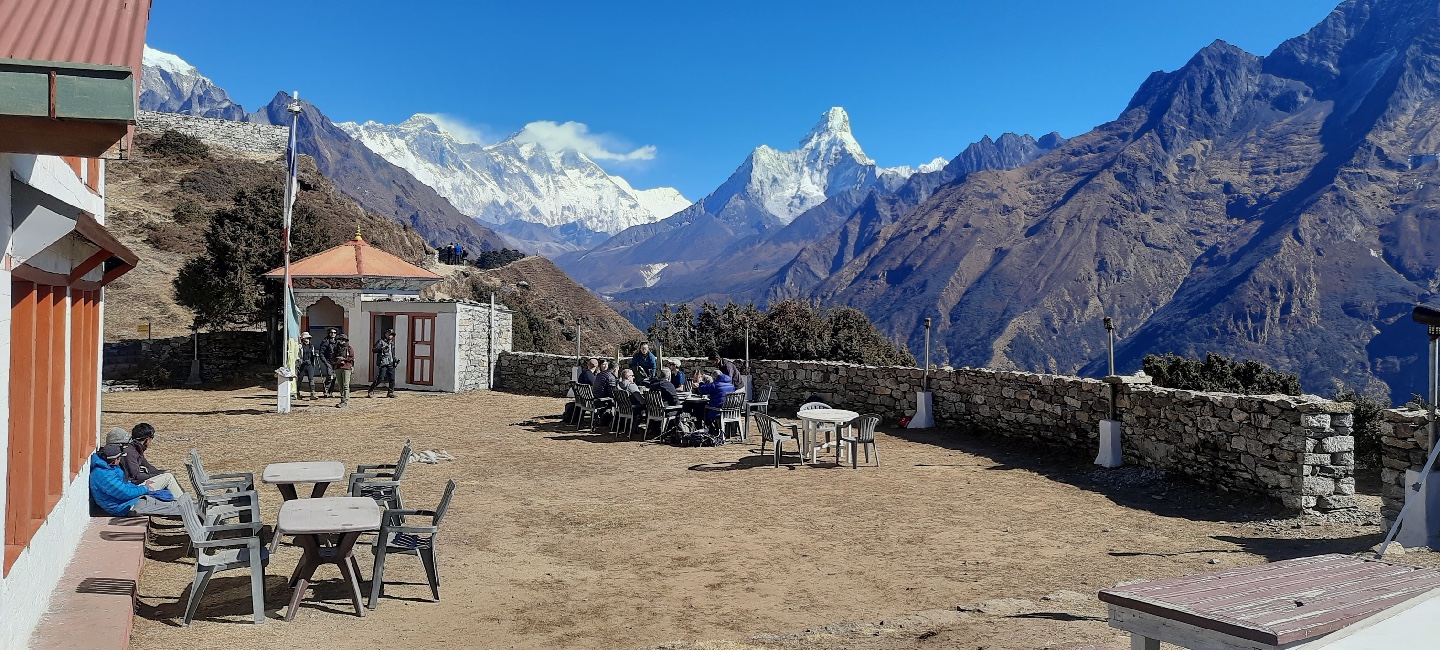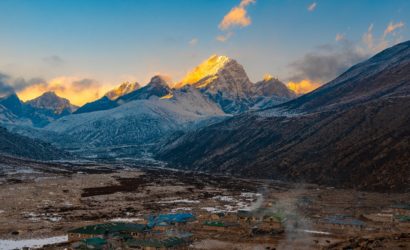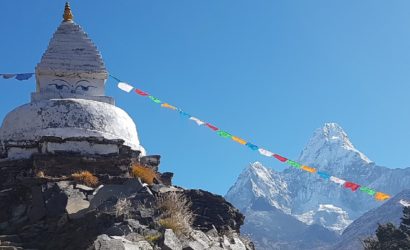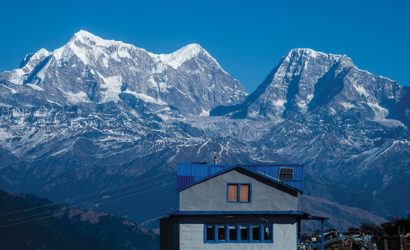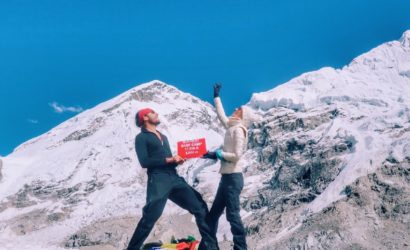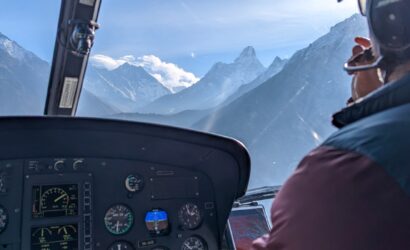Are you looking for a close alternative destination from Everest Base Camp Trek? If yes, then Ama Dablam Base Camp Trek can be one of the ideal options for you. This trek is one of the most rewarding treks in the Everest Region.
Thrilling but yet not discovered by many trekkers, Ama Dablam Base Camp is a beautiful destination that adventure enthusiasts dream for. This is a less crowded trek route that serves you well with the views of the snow-capped peaks. The scenery of Mount Everest, Ama Dablam, Nuptse, and Lhotse are awe-inspiring from the base camp.
How To Reach Ama Dablam Base Camp?
Our journey to Ama Dablam Base Camp Trek starts from Kathmandu with around 35 minutes of flight to Lukla. From Lukla, we will head towards Phakding at 2650 meters above sea level as we walk uphill through the dense forests of rhododendron and pine trees.
We will step into the premises of the Sagarmatha National Park and maybe we can encounter some endangered animals, such as Snow Leopard, Red Panda, and Musk Deer. Make sure you have all the required permits and documents with you before you step into the UNESCO Heritage Site, Sagarmatha National Park.
We will reach Namche Bazaar on the next day at 3440 meters after walking around 5 to 6 hours from Phakding. Namche, the Gate to Everest, is a beautiful Sherpa town filled with vibrant culture and lifestyle. You can get the blend of both Nepali and Western cuisine and culture. Namche has modern cafes, restaurants, bars, souvenir shops, and even bakeries.
From Namche, we will head towards Tengboche and then to Pangboche before diverting our way to Ama Dablam Base Camp from the standard Everest Base Camp route. The trails take you through many small villages past many Stupas and mani walls.
We will experience the grandeur of Mount Everest, Ama Dablam, Nuptse, and Makalu from Ama Dablam Base Camp on our significant day. After exploring the breathtaking surroundings, we’ll retrace our steps via Phortse, returning through Monjo, Phakding, and concluding the journey in Lukla.
Highlights of Ama Dablam Base Camp Trek
- Reach at the lap of Mount Ama Dablam (6,856m/22,494ft).
- 360 views of Mount Everest, Lhotse, Nuptse, and Ama Dablam.
- Explore wild flora and fauna at Sagarmatha National Park.
- Vibrant settlements at Namche Bazaar.
- Visit Tengboche Monastery and learn the ancient Buddhist facts.
Best Time For Ama Dablam Base Camp Trek
Spring (March to May)
Trekkers can experience the vibrant beauty of Spring on the Ama Dablam Base Camp Trek. As winter fades away and this delightful season starts, the trails come alive with blooming Rhododendrons, painting the landscape in shades of pink, white, and red. The lush green forests create a serene backdrop for trekkers, providing a breathtaking environment.
Spring offers excellent visibility, allowing trekkers to enjoy clear views of the snow-capped peaks, including the majestic Mount Everest, Ama Dablam, Lhotse, and more. The milder conditions make hiking enjoyable, with warm evenings replacing the cold of winter.
Local communities, thriving in Spring, extend warmth and hospitality to trekkers, offering not just a visual spectacle but also cultural insights. Immerse yourself in the rewarding experience of Spring on the Ama Dablam Base Camp & nearby region, where nature and culture come together to enhance your trekking journey.
Autumn (September to November)
Other than Spring, Autumn season (September-November) is also the best time to experience the Ama Dablam Base Camp Trek in the full bloom of all its glory. This has clear skies, the stability of the period after the rains and the refreshed air in post-monsoon.
The monsoon rains bring life to the landscape and make it a verdant paradise. The clear view obtained during this period makes sightseers enjoy the glorious mountains and valleys.
The autumn climate is stable, with warm days and cool evenings, perfect for enjoyable walks. This season also aligns with numerous Nepalese festivals, providing trekking enthusiasts with the opportunity to immerse themselves in local cultural events.
Required Permits
There is one permit that is required for the Ama Dablam Base Camp Trek, which is none other than Sagarmatha National Park Entry Permit. Ama Dablam Base Camp lies within Sagarmatha National Park region. So trekkers must obtain this permit to embark on the trek.
To get this permit, you can visit Nepal Tourism Board in Kamaladi, Kathmandu. You can also get it from the Monjo Checkpost near Phakding Village during your trek. Your guides also can help you obtain these permits. You must submit the documents like passports, valid visa, photographs, and fees.
The cost of Sagarmatha National Park Entry Permit is NPR. 3000 per person and Khumbu Rural Municipality Permit (Trek Card) NPR: 2000 per person for the foreign trekkers. If you are from the South Asian Countries (SAARC Nations), your cost will be NPR. 1000 per person and Khumbu Rural Municipality Permit (Trek Card) NPR: 2000 per person Similarly, trekkers from Nepal must pay NPR. 100 per person to obtain this permit.
Itinerary
On the first day of the Ama Dablam Base Camp, we welcome every trekker affiliated with us. Our officials will pick them from Tribhuvan International Airport and escort them to their respective hotels.
Also, we have a meet and greet program at Himalaya Discovery Office, where you can meet the tour operators, guides, and other crews. Later, our trekkers will stay at a hotel with amenities like a personal bedroom with an attached bathroom and more.
Today, we will explore the beauty of Kathmandu Valley. Starting our morning from Pashupatinath Darshan, we will also visit Swayambhunath and Boudhanath, which offer detailed insights into our culture and religion.
Also, we will explore Kathmandu’s rich history at Durbar Square, once the Royal Palace for Malla and Shah Kings. We can view grand halls, expansive courtyards, and centuries-old royal treasures. Additionally, we can also visit and discover the Narayanhiti Palace, now a museum showcasing the artifacts and possessions of the Shah Kings.
Later, we will return to our respective hotels for overnight stay.
The third day sees us flying towards Lukla which is at an elevation of 2,860 meters above sea level from Kathmandu in only 45 minutes. We can get breathtaking views of the old towns and villages, and the magnificent Himalayas as seen from above.
Upon our arrival at Lukla Airport, commonly known as Tenzing Norgay Sherpa Airport, we will have a short resting time and then make our way uphill, walking for about 3 – 4 hours to Phakding that is situated at an elevation of 2,610 meters.
Our next stop is Namche Bazaar, the Gateway to Mount Everest, situated at 3430 meters above sea level. The journey from Phakding village takes 5 to 6 hours and requires physical preparedness. It is recommended to wear comfortable and sturdy hiking boots with proper grip for safety.
Namche is an ancient town in Everest Region with much culture of Sherpa and top class facilities. This also affords plenty of possibilities for culture involvement and many activities. It is also a viewpoint for the beautiful sights of Mount Everest, Ama Dablam and Lhotse.
To reach Namche, take an uphill trail from Phakding, passing through settlements like Bengkar before reaching Monjo Village. Monjo is where you can obtain trekking permits for the Ama Dablam Base Camp Trek if not purchased in Kathmandu.
We will continue our trek along the uphill trail through Jorsalle and Larja Dobhan before arriving at Namche Bazaar, our destination for Day 02. Overnight accommodation will be at a guest house, allowing you to enjoy the diverse nature of the surroundings.
We shall rest for a day today to make sure we acclimatize. Adapting to the high altitude which is at 3430 meters above sea level, a process known as acclimatization, is important for this. Our bodies burn out as we trek from Lukla to Namche Bazaar. It is critical to restore energy and stamina.
On the sixth day of the Ama Dablam Base Camp trek, we will continue our journey to Tengboche, a traditional Buddhist village situated at 3860 meters above sea level. The approximately 5 to 6-hour trek from Namche Bazaar takes us through lush green forests along the Bhote Koshi River.
The trail to Tengboche begins on the right side of Namche Bazaar and extends to Phunke Tenga village. Along the way, captivating views of Mount Everest, Ama Dablam, and Lhotse unfold, with distant green hills and deep valleys enhancing the scenery.
The old Buddhist Monastery known as Tengboche Monastery is located in Tengboche village created in 1916 by Lama Gulu. Kumbum is the largest gompa in the Everest region. On the sixth day, the trail from Namche to Tengboche blends the natural and cultural beauty of the greater Everest region.
Today, we will embark on a scenic 5 to 6-hour trek from Tengboche to Pangboche, traversing remote and rugged pathways amidst breathtaking natural beauty. We will start our day with breakfast in Tengboche and set off on a journey through the picturesque Imja Valley.
After a few hours, arrive at Deboche, home to the ancient Deboche Monastery—one of the oldest Tibetan Buddhist worship sites in the Himalayas. Continuing onward, reach Pangboche in approximately 1.5 hours, where you’ll be captivated by the majestic Himalayan scenery.
The way from Pangboche to Ama Dablam Base Camp is divinely beautiful while offering a thrilling experience. As you get closer to Ama Dablam, you can observe the details of this mountain and understand the reason behind its name – ‘Mother’s Necklace”.
We will climb from Pangboche and cross Imja Khola and start our ascent to Ama Dablam. You will be at a base camp in an instant and the sights are great from the top.
The views of Everest (8,848m), Amadablam (6,812m), Lhotse (8,516m), Kantega (6,782m), and other peaks will leave you imagining more. We spend good quality time enjoying the snow topped mountains and thereafter head towards Pangboche.
Today, we will begin the descent from Pangboche on the right side, proceeding towards Phortse. Situated at an elevation of 3930 meters, Phortse is a picturesque settlement in the Everest Region, providing breathtaking views of Mount Everest and Ama Dablam.
After departing from Pangboche, the journey involves traversing Buddhist settlements, reaching Phortse within 3 to 4 hours. Accommodations will be at a local tea house in Phortse.
The journey starts on day eleven of the Ama Dablam Base Camp Trek out of Phortse. Having said bye to this Buddhist settlement, the first thing will be to pass through Phortse Thanga at 3680 meters.
From there, we will continue our trek towards Khumjung Valley and then arrive at the bustling town of Namche Bazaar. After resting there for some time, we will continue descending towards Monjo Village. There’s an Army Post where trekkers can buy Sagarmatha National Park Entry Permit during the start of their trek.
From Namche, we must traverse Larja Dobhan and Jorsalle village. Tonight, we will stay at a tea house.
Today, we will directly reach Lukla from Monjo. Our trek starts after a warm breakfast in Monjo. First, we will start hiking towards Toktok and Bengkar village.
After passing through several Buddhist settlements, we will reach Phakding. From Phakding, we will enjoy the descent with the fresh views of the Himalayas. We will traverse Chheplung and Nurning village before we make it to Lukla.
This is the last day of the Ama Dablam Base Camp Trek. We will onboard a flight from Lukla Airport to Tribhuvan International Airport. The flight duration is around 35 minutes.
In the evening we will have a farewell dinner in a traditional Nepalese restaurant with cultural performances
Today you can either stay back and enjoy a free day in Kathmandu or leave for your respective countries. Enjoy your last moments in Kathmandu with breakfast in a café, a city walk or souvenir shopping.
Our representative will meet you at your hotel and drive you to the airport for your return flight home.

